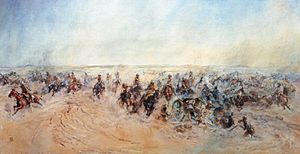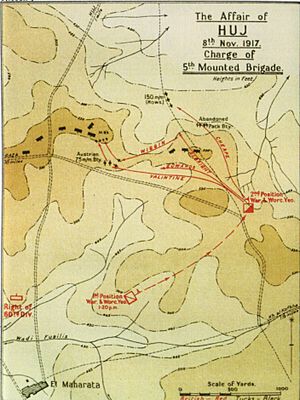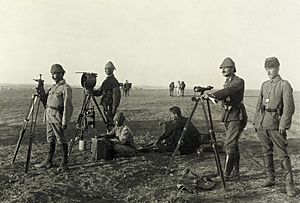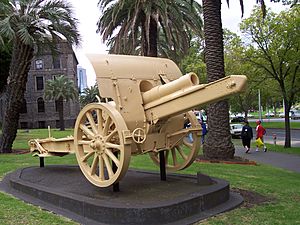Charge at Huj facts for kids
Quick facts for kids Charge at Huj |
|||||||
|---|---|---|---|---|---|---|---|
| Part of the Middle Eastern theatre of World War I | |||||||
 Charge at Huj, by Lady Butler |
|||||||
|
|||||||
| Belligerents | |||||||
| Units involved | |||||||
| Worcestershire Yeomanry Warwickshire Yeomanry |
Part of XXI Corps | ||||||
| Casualties and losses | |||||||
| 26 dead 40 wounded |
100+ dead 70 prisoners 11 artillery guns 4 machine guns captured |
||||||
The Charge at Huj was a brave battle that happened on November 8, 1917. It was fought between soldiers from the British Empire and the Ottoman Turkish Empire during World War I. This event took place in a region called Palestine.
During the charge, British horse-mounted soldiers, called yeomanry, attacked a strong group of German, Austrian, and Turkish soldiers. These enemy soldiers had powerful artillery guns and machine guns. Even though the British faced heavy fire, they won the battle! They captured the enemy position, 70 prisoners, 11 artillery guns, and 4 machine guns. However, the British also suffered many losses: 26 soldiers died, 40 were wounded, and 100 horses were killed.
This charge is known as one of the last great cavalry charges in British history. It was made famous by a painting from a well-known artist, Lady Butler.
Contents
What Led to the Charge at Huj?
Huj is a village located about 9.3 miles (15 km) northeast of Gaza. During a big battle called the Third Battle of Gaza, most Turkish forces had left the area by November 5, 1917.
On November 8, 1917, British forces were moving forward. They were stopped by heavy artillery fire from a strong enemy group. This group was positioned on a high ridge south of Huj. The Turkish soldiers were protecting the retreat of their army headquarters. This rearguard included German, Austrian, and Turkish artillery, about 300 infantry soldiers, and six machine guns. The British commander knew his infantry division would struggle to take this position alone. So, he asked for help from his mounted troops.
The Daring Attack
The only mounted troops nearby were 170 yeomanry soldiers. These were two full squadrons and two half squadrons from the Worcestershire Yeomanry and Warwickshire Yeomanry regiments. They were part of the British 5th Mounted Brigade.
The yeomanry moved carefully, using the land for cover, until they were about 1,000 yards (914 meters) from the enemy. They then got even closer, to about 300 yards (274 meters), before drawing their swords and charging!
- One squadron of the Warwickshire Yeomanry attacked the main group of Turkish infantry. Then, they turned and attacked the enemy's gun line.
- The other half squadron from the Warwickshire Yeomanry and the Worcestershire Yeomanry squadron attacked the guns from the front.
- The remaining troops attacked an infantry position located behind the main enemy force.
The German and Austrian artillerymen kept firing until the horsemen were only about 20 yards (18 meters) away. Then, some of them hid under their guns. Those who stayed standing were mostly stabbed by the British swords. Others who tried to run away saved themselves by lying on the ground.
Lieutenant Mercer, one of the few officers from the Worcestershire Yeomanry who wasn't hurt, described the charge: "Machine guns and rifles opened fire on us the moment we came over the hill. The sound of bullets was like a hailstorm on an iron roof. Many men and horses fell close to the guns. Our squadron seemed to disappear. For a moment, I thought I was the only one left alive. I was amazed to find out we had won."
All three attacks were successful. The main enemy infantry group retreated, leaving their guns unprotected. The yeomanry captured 70 prisoners, 11 artillery guns, and 4 machine guns. The British lost 26 men, including three squadron commanders, and 40 were wounded. Also, 100 horses were killed during the charge.
What Happened After the Charge?
The Charge at Huj cleared the way for the British forces to keep moving forward. It had destroyed the last strong enemy position south of Huj village, which was captured later that day.
However, the British yeomanry regiments were too tired and had lost too many men and horses to chase the retreating Turkish forces. The pursuit was also made harder by problems with getting water for the horses and a lack of supplies, partly due to bad weather. The main British forces didn't continue their advance until November 9-10.
The Charge at Huj has been called "the last great charge of the British cavalry." It was made famous by a watercolour painting by Lady Butler, which is now in the Warwickshire Yeomanry Museum.
Major Oscar Teichman, a medical officer, wrote in 1936: "The Charge at Huj, if it had happened in a smaller war, would be as famous as the Charge of the Light Brigade at Balaclava. In World War I, where brave acts happened almost daily, it was just one event. But for pure bravery, it remains unmatched."
Visitors to the Warwickshire Yeomanry Museum in Warwick, England, can see a 75mm Turkish Field Gun. This gun was captured during the charge and is now on display there. It shows the lasting connection between the New Zealand Division and the Warwickshire Yeomanry, formed during World War II.
Images for kids








